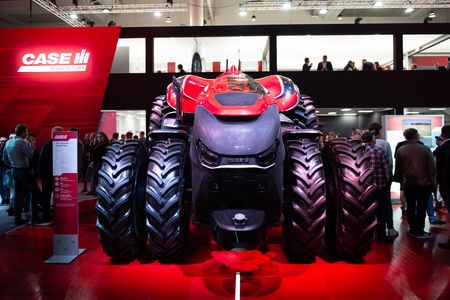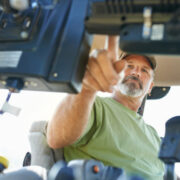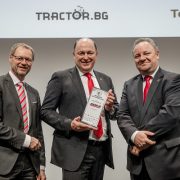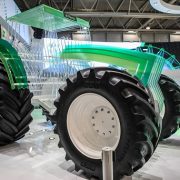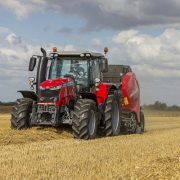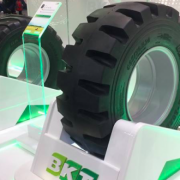Autonomous Systems at Agritechnica 2023
Autonomous field work is no longer a distant prospect with robots increasingly finding their way into practical applications. However, further development work is needed before they can be used on a broader scale and fundamental safety issues still need to be clarified – Agritechnica, 12-18 November, 2023.
Advanced developments in mobile machines have made it possible that autonomous machines will be cultivating arable land on a large scale and indeed, the transition to driverless field robots has already begun. Autonomous systems offer great opportunities for agriculture and can provide useful support for farms in their daily work.
From sowing and crop protection to harvesting and tillage, autonomous robots can contribute significantly to field work, support the conservation of both natural resources and soil. By performing labor-intensive tasks such as weeding, field robots can also help address labor shortages and, thanks to scalable technology, the autonomous systems of the future will also be a viable prospect for smaller farms.
All major agricultural machinery manufacturers, as well as startups and smaller companies, are currently working on commercial field robots and on systems for the full or partial automation of field work. What can be expected from this technology? At Agritechnica 2023, 12-18 November, Hanover, Germany, numerous companies will be presenting their solutions and providing answers to important questions from farm managers.
Autonomous or fully automated
Autonomy in agricultural machinery can be fundamental to the design, such as field robots or, alternatively, existing tractors, harvesters and implements can be modified. There is as yet no generally accepted definition of what distinguishes an autonomous system from a fully automated one. However, the automation of existing implements, such as fertilizer spreaders or crop protection sprayers, provides the foundation for autonomy.
Autonomous tractors and implements could replace today’s “non-intelligent” tractor-implement combinations in the not too distant future. A transition from automated to autonomous systems is already taking place, in which innovative sensor and robotics technologies, but not necessarily complete systems, can support farm work.
Autonomous technology in the real world
Autonomous field robots for cultivation and maintenance already perform farming tasks such as sowing and mechanical weed control, either as single-function robots or as part of a system solution. In many cases, field robots still cannot compete with standard technology in terms of performance and robustness but their advantage lies in the considerable potential savings due to round-the-clock working. Driverless vehicles can be used individually or in swarms.
Sensor technology plays a crucial role in the further development of modern robots. Passive and active sensors with many different operating principles have an enormous potential range of application, especially when different sensors are used in combination. This is known as sensor fusion.
Increasing importance of artificial intelligence
Field robots will be capable of tackling significantly more demanding tasks over time. Artificial intelligence (AI) will enable them to perceive their environment, process what they perceive and solve tasks and problems independently. An AI unit learns from recorded or selected training data by searching for patterns and recurring structures from which laws can be derived.
Important safety issues still unresolved
In order to fully exploit the potential of autonomous agricultural systems, such as self-driving tractors, sowing or weeding robots, innovative solutions are needed for safe operation. There are two basic options: either the operational environment is designed to eliminate the risk, or the autonomous system can reliably recognize and avoid hazardous situations. An example of the former, so-called “virtual fences” trigger an emergency stop, should the field robot cross a predefined boundary. For the latter, robots can be designed to reliably detect hazardous situations on their own, using, for example, lidar sensors (light detection and ranging), which detect obstacles even at greater distances. Nevertheless, any single sensor technology is unlikely to provide the required robustness on its own and multiple sensor systems with “sensor fusion”, the optimal combination of data from multiple sensors of differing type, will be needed to provide the necessary quality. Both sensor systems and data fusion make increasing use of artificial intelligence and machine learning.
The central question of the legal approval of autonomous machines remains open. The European Machinery Directive requires the safe exclusion of a hazard, requiring manufacturers to demonstrate a safety system for an unattended machine in the field. Autonomous road transport instead of manual relocation of the machines is also still unresolved.
The “human factor” remains
Despite all the automation, autonomy and artificial intelligence, human involvement will continue to be indispensable in many areas. The more complex the task, the more difficult it is to fully automate. Even though more and more field robots will be making their rounds on farmland, a human must take the crop management decisions and adapt and program the autonomous systems for that site.
Autonomous and fully automated systems and solutions can undoubtedly support farm managers in their decision-making but the ultimate responsibility remains with them, not the machine.
Solutions must pay off
Ultimately, cost-effectiveness will determine whether and how autonomous systems can gain a broader practical foothold. Cost savings for cab, suspension and operation are offset by additional expense for redundant control systems and sensors for collision avoidance. A big plus of these systems is higher utilization, as a robot does not need breaks and must only interrupt its work to refill with consumables or for daily maintenance. The market success of autonomous systems will ultimately depend above all on a clear legal framework and suitable business models.
Purchase, rent or service provider
Various business models are available for the use of autonomous systems, such as buying or renting robots or contracting them in as a service. With buying comes the risk that today’s latest technology may be tomorrow’s discontinued model due to the rapid pace of technical development. In the case of renta as well as purchase, the technical expertise needed to operate the machinery may be a challenge. An alternative to both can be the use of equipment and knowledge from a service provider. The options for an individual company are likely to depend primarily on the individual circumstances and the complexity of the technology.
Agritechnica 2023: Showcase of current technologies and developments
In the future, autonomous systems will support economical arable farming, especially on large-scale farms. Thanks to scalable technology, smaller-scale farms with extensive labor-intensive manual work such as organic farming and vegetable cultivation can equally benefit.
A wide variety of field robots will be on display at many stands at Agritechnica this November – for use in corn, potatoes, vegetables and other field crops, and for work such as crop protection, tillage and other applications. Manufacturers, start-ups and universities will be presenting their concepts and solutions for highly automated agriculture in Hanover. Visitors to Agritechnica 2023 will have ample opportunity to exchange ideas with exhibitors about their solutions and to find out in detail about robotic and other autonomous systems in Agritechnica 2023.




